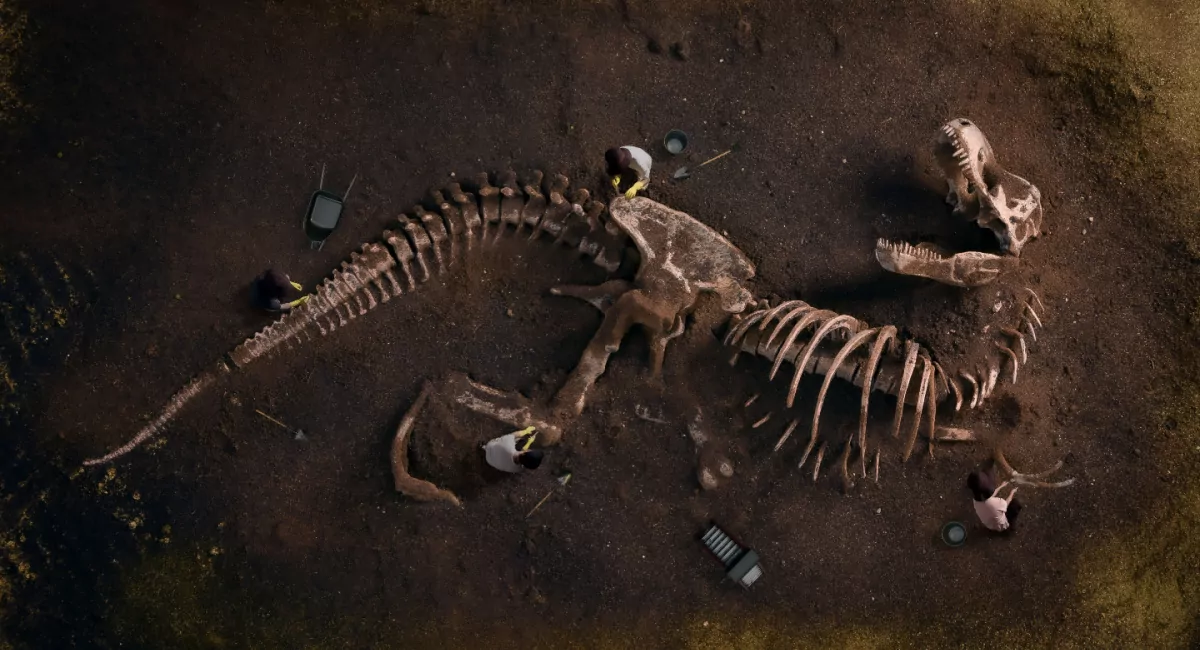
The fossil record is a fascinating window into the ancient history of our planet. It provides incredible insights into the organisms that once roamed the Earth and allows us to better understand the evolution of life over millions of years. Fossils are the remains or traces of ancient plants, animals, and other organisms that have been preserved in sedimentary rocks. They serve as tangible evidence of past life and provide scientists with valuable clues about Earth’s biodiversity and the adaptations of different species.
In this article, we will explore 16 fascinating facts about the fossil record. From the oldest known fossils to astonishing discoveries, these facts will highlight the significance of fossils in reconstructing the history of life on Earth. So, get ready to embark on a journey through time and discover some remarkable insights from the world of paleontology!
Key Takeaways:
- Fossil records are like time capsules that hold clues about ancient life forms, ecosystems, and Earth’s history, helping scientists understand evolution and past climates.
- Fossils provide tangible evidence of the incredible diversity of life on Earth, from massive dinosaurs to tiny microorganisms, offering a window into our planet’s rich history.
Fossil records provide valuable insights into ancient life forms.
The fossil record is an incredibly rich and diverse source of information about the history of life on Earth. It provides a unique window into the past, allowing scientists to study and understand the evolution of various organisms over millions of years.
Fossils are the preserved remains or traces of ancient organisms.
Fossils can include bones, shells, teeth, footprints, imprints, and even preserved soft tissues. These remnants offer tangible evidence of the plants, animals, and other organisms that once inhabited our planet.
Fossils can be formed in a variety of ways.
Fossils are typically formed through processes such as mineralization, where the organic material is replaced by minerals, or through the preservation of original organic material in substances like amber or tar.
Scientists use fossils to reconstruct past ecosystems and environments.
By studying the distribution and types of fossils within a particular area, scientists can gain insights into ancient habitats, climate patterns, and ecological interactions.
Fossils can be used to date rocks and determine the age of Earth’s geological formations.
By analyzing the age of the rocks in which fossils are found, scientists can determine the relative and absolute ages of different geological events, providing important evidence for Earth’s history.
The fossil record provides evidence for evolutionary change over time.
Fossils allow scientists to track the development and diversification of species, providing a tangible record of the evolutionary processes that have shaped life on Earth.
Fossil records have revealed some of the largest and most iconic creatures that ever existed.
The fossil record includes incredible finds such as the enormous Tyrannosaurus rex, the massive woolly mammoth, and the majestic Megalodon.
Fossils have helped scientists understand the mass extinctions that have occurred throughout Earth’s history.
By studying the fossil record, scientists have been able to identify major extinction events and gain insights into the causes and consequences of these catastrophic events.
Fossils provide valuable evidence for human evolution.
The discovery of ancient hominin fossils has greatly contributed to our understanding of human evolution and our place in the history of life on Earth.
The fossil record is constantly evolving.
New discoveries and ongoing research continue to expand our knowledge of prehistoric life and reshape our understanding of Earth’s history.
Fossil records are not limited to land-dwelling organisms.
Marine fossils, such as those of ancient corals, shells, and marine reptiles, provide insights into the evolution of the oceans and the diverse life forms that have inhabited them.
Fossils can reveal details about an organism’s anatomy and behavior.
Well-preserved fossils can provide intricate details about the structure, locomotion, feeding habits, and social behavior of ancient organisms.
Fossils can help solve mysteries and answer long-standing questions in paleontology.
The study of fossils has allowed scientists to unravel the mysteries surrounding the origin of life, the development of complex ecosystems, and the processes driving evolutionary change.
Fossils are found on every continent, providing a global perspective on Earth’s past.
From the trilobites of North America to the ancient hominin fossils of Africa, the fossil record is a global archive of life throughout history.
Fossil records provide insights into the history of climate change.
By studying the fossil record, scientists can determine how past organisms responded to environmental changes, helping us better understand the impact of current and future climate change.
The fossil record gives us a glimpse into the incredible diversity of life that has existed on Earth.
From the smallest microorganisms to the largest dinosaurs, the fossil record showcases the vast array of species that have inhabited our planet throughout its history.
Conclusion
In conclusion, the fossil record provides us with a fascinating window into the past. Through the study of fossils, scientists have been able to piece together the history of life on Earth, uncovering incredible insights about evolution, ancient environments, and the diversity of species that once existed. From the discovery of new species to the understanding of mass extinctions, the fossil record continues to amaze and captivate scientists and researchers around the world.By examining fossils, we gain a deeper understanding of the world we live in and how it has changed over millions of years. These ancient remnants serve as tangible evidence of the incredible journey life has taken on Earth and offer valuable insights into the future of our planet. The fossil record is an invaluable resource, allowing us to unravel the mysteries of our past and offering glimpses into the rich tapestry of life that has inhabited our planet throughout history. As we continue to explore and uncover new fossils, the story of life on Earth will continue to unfold, bringing with it new revelations and exciting discoveries.
FAQs
Q: What is the fossil record?
The fossil record refers to the collection of all known fossils, which are the preserved remains or traces of ancient organisms. It provides valuable evidence of past life on Earth and serves as a record of the history of life.
Q: How are fossils formed?
Fossils are formed through a process called fossilization. This occurs when the remains or traces of organisms are preserved in sedimentary rock or other fossil-bearing materials. Over time, the organic matter is replaced by minerals, resulting in the formation of a fossil.
Q: What can fossils tell us?
Fossils can tell us a great deal about the organisms that lived in the past, including their anatomy, behavior, and evolutionary relationships. They also provide evidence of past climates, ecosystems, and environmental changes.
Q: How old are fossils?
Fossils can range in age from a few thousand years old to over 3 billion years old, depending on the type of fossil and the geological context in which it is found.
Q: Where are fossils found?
Fossils can be found in various locations around the world, including sedimentary rocks, caves, and ice. They can also be found in marine environments, such as coastal cliffs and seabeds.
Q: How do scientists study fossils?
Scientists study fossils through a variety of methods, including excavation, analysis of their structure and composition, and comparisons with living organisms. They also use advanced techniques, such as CT scanning and DNA analysis, to gain further insights.
Q: Can fossils be found in every rock?
No, fossils are primarily found in sedimentary rocks, which are formed from layers of sediments. These rocks have a higher likelihood of preserving fossils compared to other types of rock.
Q: Are all fossils of dinosaurs?
No, while dinosaurs are a well-known group of ancient organisms, the fossil record includes a wide range of other organisms, such as plants, insects, mammals, and even microscopic organisms.
Q: How do fossils help in understanding evolution?
Fossils provide direct evidence of past life forms, enabling scientists to study the changes that have occurred over time. By comparing fossils from different time periods, researchers can trace the evolutionary relationships between species and gain insights into the processes of evolution.
Q: Can fossils help in predicting future environmental changes?
Yes, by studying the fossil record, scientists can gain insights into how organisms have responded to past environmental changes. This knowledge can help inform predictions about how current ecosystems may be affected by ongoing environmental changes.
Fossil records offer tantalizing glimpses into Earth's past, but many more fascinating creatures and evolutionary mysteries await your discovery. Unearth the secrets of Archen, a prehistoric bird with a unique blend of avian and dinosaurian features. Explore the captivating field of evolutionary paleontology, where scientists piece together the intricate puzzle of life's history. While fossils reveal extinct species, observing living creatures like the majestic owls found in the wild provides a connection to the present-day wonders of nature.
Was this page helpful?
Our commitment to delivering trustworthy and engaging content is at the heart of what we do. Each fact on our site is contributed by real users like you, bringing a wealth of diverse insights and information. To ensure the highest standards of accuracy and reliability, our dedicated editors meticulously review each submission. This process guarantees that the facts we share are not only fascinating but also credible. Trust in our commitment to quality and authenticity as you explore and learn with us.


